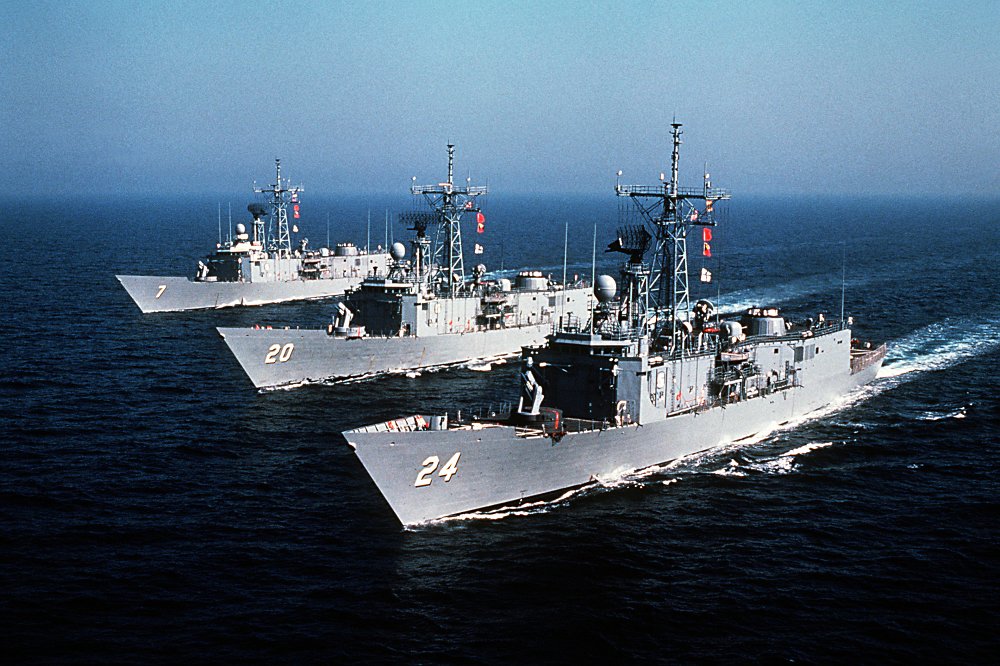Military
Ever Wanted to Buy an Actual Naval Warship? Good News, They're on Sale
Published:
Last Updated:
So you’ve got your eye on this sweet new ride — an Oliver Perry-class guided missile frigate — but you’re a little short on cash. What do you do?
Perry-class frigates USS Oliver Hazard Perry (FFG-7), USS Antrim (FFG-20), and USS Jack Williams (FFG-24). Photo: DefenseImagery.mil.
Head on down to Discount Battleships, that’s what. “No reasonable offer will be refused.” Heck, even if an entirely unreasonable offer is the best you’ve got — you may be in luck! For a lucky few buyers, Secretary of Defense Chuck Hagel is offering to sell off America’s fleet of frigates — and the prices are insane!
What’s under the hood
The United States Navy currently has 11 Perry-class frigates on active-duty. And these warships are so popular that they currently serve in the navies of eight other nations around the globe — Australia, Bahrain, Egypt, Pakistan, Poland, Spain, Taiwan, and Turkey.
Displacing 4100 metric tons, the Perrys are about one-third bigger than the Navy’s new littoral combat ships that are meant to replace them (although at 30 knots max speed, they’re a bit slower). The vessels generally sport 76-mm MK 75 cannon, Raytheon (NYSE: RTN) MK15 Phalanx Close-In Weapon Systems for air defense, and multiple machine guns for dealing with small surface combatants. In addition, depending on their configuration, these warships can carry everything from torpedoes to Boeing (NYSE: BA) Harpoon anti-ship missiles, to surface-to-air Standard Missiles.
Who wants one?
As recently reported on DefenseNews.com, the U.S. Congress has approved the sale of eight Oliver Hazard Perry-class frigates to America’s allies. Taiwan is expected to snap up four of them, Thailand will take two more, and two could go to Mexico. That leaves three more Perrys available for resale, and word has it that both Pakistan and Turkey want to get hold of them.
How low can you go?
Earlier this year, the Philippines Navy began negotiations to acquire as many as four old Hamilton–class U.S. Coast Guard cutters for about $10 million each. The U.S. Navy won’t let its Perry-class frigates for quite that low. But as we learned last year, it is negotiating to sell a pair of Perrys to Taiwan for a little under $100 million apiece.
That’s about half of what the vessels cost to build back when they were new. And in inflation-adjusted terms, the $194 million that a Perry cost back in 1978 would be worth about $683 million today. So anyone who’s buying these ships can rest assured that they’ve got a lot of depreciation already factored in. No one’s going to be paying Blue Book value on these babies.
Rotate the tires, change the oil… could you throw in a towed array sonar system?
What does all of this mean? First and foremost, before taking possession of our old Perrys, it’s likely that any foreign buyers will want to get them refurbished and upgraded with modern-day tech. Taiwan, for example, is said to be looking to add AN/SQR-19 Towed Array Sonar systems from Lockheed Martin (NYSE: LMT)to its new boats.
Assuming other buyers have similar wishlists, this could mean millions of dollars in new revenues for the defense contractors tasked with upgrading the ships after their sale.
Bigger picture, the sale of the U.S. Navy’s last remaining Perrys will increase the urgency of completing the 32-ship build-out of its new littoral combat ship fleet. The lack of surface combatants could potentially spur the Navy to buy additional Arleigh Burke-class (DDG 51) guided missile destroyers from General Dynamics (NYSE: GD) and Huntington Ingalls (NYSE: HII) — or even convince the Navy to buy more of their ultramodern DDG-1000 Zumwaltdestroyers.
Moral of the story: The more old warships the U.S. Navy unloads on the cheap, the more new warships it will need to buy to replace them — and the more money America’s leading defense contractors can charge for building them.
Special free report: Top dividend stocks for the next decade
Big news stories can change every day, but great dividends last much longer. And the smartest investors know how much that adds up to over the long run. That’s why top analysts put together a report on a group of high-yielding stocks that should be in any income investor’s portfolio. To see our free report on these stocks, just click here now.
Start by taking a quick retirement quiz from SmartAsset that will match you with up to 3 financial advisors that serve your area and beyond in 5 minutes, or less.
Each advisor has been vetted by SmartAsset and is held to a fiduciary standard to act in your best interests.
Here’s how it works:
1. Answer SmartAsset advisor match quiz
2. Review your pre-screened matches at your leisure. Check out the advisors’ profiles.
3. Speak with advisors at no cost to you. Have an introductory call on the phone or introduction in person and choose whom to work with in the future
Thank you for reading! Have some feedback for us?
Contact the 24/7 Wall St. editorial team.